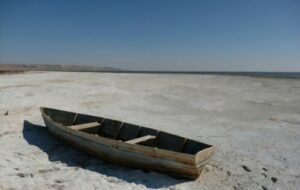From 6 to 18 November 2022, the Government of the Arab Republic of Egypt will host COP27 in Sharm el Sheikh, intending to build-upon the accomplishments of previous conferences, and oversee negotiations on mitigation, adaptation and financing to elicit favourable results to pave the worldwide ambition to challenge the global challenge of climate change together.
 One would hope that as the attendees enjoy the world-renowned Egyptian hospitality, and view the idyllic beaches and the breathtaking beauty of the Red Sea, it gives them a renewed focus as this very area will be devasted by climate change if the current planned targets are not met or exceeded.
One would hope that as the attendees enjoy the world-renowned Egyptian hospitality, and view the idyllic beaches and the breathtaking beauty of the Red Sea, it gives them a renewed focus as this very area will be devasted by climate change if the current planned targets are not met or exceeded.
Global warming will trigger exceptional heat waves occurring over Africa if the temperatures are not significantly controlled. Already a dessert area, the effect on the ecology, natural water sources, fertile land and crops would be irreparable – think Death Valley in California!
The Red Sea is already the warmest sea in the world and the saltiest “living” ocean/sea, with extreme evaporation levels. An increase in evaporation due to these heat waves would significantly increase the salt percentage, reduce oxygen levels, destroy the reefs and most likely kill a number of underwater sealife. In fact most warm water reefs would be unlikely to survive if controls aren’t met. Whereas other countries could be living in fear of rising waters, increased evaporation on the red sea could reduce it. Who knows what impact that would have on the Suez Canal?
 The situation should no longer be referred to as global warming but as climate crisis, and whereas it was always perceived as a far-off problem for future generations, time has caught up with us. The effect of climate change has already shown itself with storms, floods and wildfires intensifying all over the world, plus extreme heatwaves such as those experienced in the Balkans (2007), France (2003), and Russia (2010). The health of tens of millions of people is also being compromised by poor air quality. Change needs to be made now, and this decade is make or break time for the future of the planet and thousands of it’s inhabitants.
The situation should no longer be referred to as global warming but as climate crisis, and whereas it was always perceived as a far-off problem for future generations, time has caught up with us. The effect of climate change has already shown itself with storms, floods and wildfires intensifying all over the world, plus extreme heatwaves such as those experienced in the Balkans (2007), France (2003), and Russia (2010). The health of tens of millions of people is also being compromised by poor air quality. Change needs to be made now, and this decade is make or break time for the future of the planet and thousands of it’s inhabitants.
What is a COP?
For almost three decades the UN has been instrument in bringing together most of the world’s countries to tackle the issue of global warming, during which time climate change has changed from being a fringe issue to a world priority.
Conference of the Parties or COP first emerged from the UN Conference on Environment and Development, often referred to as the Earth Summit, which took place in Brazil in 1992. Three COPs were created covering biodiversity, climate change and desertification.
 The first climate change conference, COP1, was held in Berlin in 1995. At this conference is was agreed that the previous commitment to return C02 levels to post 1990 levels by the year 2000 was not adequate and direct intervention was required long after this date. From this the Berlin Mandate was born, which called on governments to establish specific, legally-binding targets and timetables for reducing developed country emissions of greenhouse gases.
The first climate change conference, COP1, was held in Berlin in 1995. At this conference is was agreed that the previous commitment to return C02 levels to post 1990 levels by the year 2000 was not adequate and direct intervention was required long after this date. From this the Berlin Mandate was born, which called on governments to establish specific, legally-binding targets and timetables for reducing developed country emissions of greenhouse gases.
Throughout the history of the yearly COP meetings just small steps forward were made without any real time commitment, as well as large steps backwards such as when the Bush Administration pulled out altogether and attended just as observers after refusing to accept the agreement signed by President Clinton since they did not want to be tied down to specifics, wanting to just stick with an agreement to a general reduction.
COP21 held in Paris in 2015 was momentous, the most significant conference since inception, as each country agreed to submit its own pledge on reducing their emissions reductions (known as Nationally Determined Contributions, or ‘NDCs’)in a joint effort to keep global warming below 2 degrees Celsius, in what became known as The Paris Agreement. Furthermore they agreed that new improved plans would be submitted every five years, allowing them to reflect their highest ambition at the time. They also committed to an aspirational target of 1.5 degrees Celsius. At this time the projected temperature rise by 2100 was predicted to be 3-4 degrees Celsius.
 COP26 held in Glasgow in 2021 had been delayed by 1 year due to the covid-19 epidemic. It was of utmost importance being the 5th year since the Paris conference where pledge changes would be made, particularly since the commitments laid out in Paris did not come close to achieving global warming to 1.5 degrees. The Paris rulebook was finalised, allowing for the trading of carbon emissions under what is known as Article 6, and the Glasgow Climate Pact agreed, which included a commitment to reduce coal power and to phase out inefficient fossil fuel subsidies (although the presidency had actually hoped to achieve zero coal power and the phasing out of all fossil fuel entirely). It had previously been shown that in order to reduce global warming by less than 2 degrees centigrade, carbon emissions need to be zero (producing less carbon than we take out of the atmosphere) by 2050 at the latest, although perhaps even more may be required to achieve this figure. By now 70% of countries had pledged to net zero.
COP26 held in Glasgow in 2021 had been delayed by 1 year due to the covid-19 epidemic. It was of utmost importance being the 5th year since the Paris conference where pledge changes would be made, particularly since the commitments laid out in Paris did not come close to achieving global warming to 1.5 degrees. The Paris rulebook was finalised, allowing for the trading of carbon emissions under what is known as Article 6, and the Glasgow Climate Pact agreed, which included a commitment to reduce coal power and to phase out inefficient fossil fuel subsidies (although the presidency had actually hoped to achieve zero coal power and the phasing out of all fossil fuel entirely). It had previously been shown that in order to reduce global warming by less than 2 degrees centigrade, carbon emissions need to be zero (producing less carbon than we take out of the atmosphere) by 2050 at the latest, although perhaps even more may be required to achieve this figure. By now 70% of countries had pledged to net zero.
Why is COP27 important?
 This conference could be the make-or-break moment for global action on climate change. The UN Secretary General has called for faster carbon cuts by the end of this year if we are to avoid catastrophe, since the latest IPCC assessment warns that the window of opportunity to avert disaster is now “brief and rapidly closing”. We knew that to have any impact we need to significantly reduce our emissions by the end of this decade, and have net zero in place by 2050. Right now the world is not on track, and the Russian-Ukrainian crisis could also prove to be another huge stumbling block.
This conference could be the make-or-break moment for global action on climate change. The UN Secretary General has called for faster carbon cuts by the end of this year if we are to avoid catastrophe, since the latest IPCC assessment warns that the window of opportunity to avert disaster is now “brief and rapidly closing”. We knew that to have any impact we need to significantly reduce our emissions by the end of this decade, and have net zero in place by 2050. Right now the world is not on track, and the Russian-Ukrainian crisis could also prove to be another huge stumbling block.
Now Egypts hold the presidency for COP27. As the representative for all of Africa (with the expectation that African countries will have some of worst exposure to the severe impact of climate change), top of the agenda will be the demand for swift clear action regarding financing for adaptation, plus reparation for loss and damage for the less wealthy and less developed countries, which had previously been pledged.
Whilst huge industrial countries like USA and China are key to the success of international global warming, its these less wealthy and less developed countries that may just tip the scales against global success if they are not supported and are unable to uphold their commitments. Clear progress is needed to turn pledges and commitments into action.
$100bn in climate finance per year was promised by developed countries, and this needs to be collected and financial assistance put into place to allow countries affected by climate change to amend their infrastructure, reform agricultural commodities to build other sources of income (for instance to prevent deforestation since forests play a vital role in removing carbon from the air, phase-out mining for commodities such as coal, etc), and allow the restoration of ecosystems as well as build defences against the effects of climate change.
Impact of Global warming
 As we stand right now, the projectory temperature is 2.4 degrees, which although somewhat commendible in that some progress has been made, is simply not enough. So you may be asking, what difference can 0.5 or one degree Centigrade really make? The answer is terrifying:
As we stand right now, the projectory temperature is 2.4 degrees, which although somewhat commendible in that some progress has been made, is simply not enough. So you may be asking, what difference can 0.5 or one degree Centigrade really make? The answer is terrifying:
At 1.5 degrees Centigrade global warming there will be a significant increase in extreme heat wave frequency and magnitude over large areas of the world, particularly affecting Africa, South America and Southeast Asia. It is anticipated that this will result in just under 14% of the population, approximately 80 million people, being exposed to extreme heatwaves at least once every five years on average, and about 600 million people once every 20 years.
Meanwhile, at 2 degrees Centigrade the frequency of extreme heat waves will almost double all over the world, with exceptional heat waves over most of Africa. Overall, more than 500 million people will be exposed to extreme heat waves on average at least once every 5 years, and more than 2 billion people (28% of projected population) at least once every 20 years. It could also result in the melting of the ice sheets in Antarctica and Greenland from which there will be no return.
 In either event we can expect large changes to the Earth as we know it. Warm water coral reefs may not survive even a 1.5 degree increase or will at least suffer from bleaching. We can expect algae to spread across the waterways, oxygen levels in the water to decrease and some species of aquatic life to perish forever. With the possible loss of fisheries our food source will become scarcer too.
In either event we can expect large changes to the Earth as we know it. Warm water coral reefs may not survive even a 1.5 degree increase or will at least suffer from bleaching. We can expect algae to spread across the waterways, oxygen levels in the water to decrease and some species of aquatic life to perish forever. With the possible loss of fisheries our food source will become scarcer too.
Established crops and other vegetation will struggle to survive in the new environment, which in addition to the severe heat may also involve major flooding. Many species of the animal kingdom may also become extinct as their natural habitat changes or completely disappears. Its a scary world in which we may find ourselves dependent on GMO food, of which the risks are already well-known.
Plus, let’s not forget the devastation that the loss of some plants could have on the healthcare of the world. It is estimated by the World Heath Organisation (WHO) that as many as 80% of the world’s population are still reliant on plants as their primary health provider, whether due to preference, cost or availability. Furthermore most of our medicines are based on naturally occurring plant chemicals which are then reproduced synthetically, and our scientists look to the plants as they seek to find new cures and better medicines.
No more delays!
 The time for complacency is over. For almost 30 years the world has been aware of the pending doom and yet failed to take any definitive action. We now have the same amount of time to reduce our ommissions to net zero, and before that just six years to significantly reduce our ommissions, preferably to half, if we are to meet the objectives.
The time for complacency is over. For almost 30 years the world has been aware of the pending doom and yet failed to take any definitive action. We now have the same amount of time to reduce our ommissions to net zero, and before that just six years to significantly reduce our ommissions, preferably to half, if we are to meet the objectives.
Although Covid-19 may have interrupted tight deadlines, it also gave us hope that the Earth can heal itself, given help. The decline in travel (both air and road) and reduced industry gave us a glimpse of how the Earth can and should be, as inspirational photos emerged of smog-free skies as air pollution dropped to unprecedented levels, coral reefs began to repair, and the waterways all over the world began to clear, for instance fish were actually visible in the usually highly polluted Venice canals and it was even rumoured that the swans had even returned there too.
 The eyes of the World will now be upon Egypt as they take over Presidency for COP27. The hope is that they can demand decisive commitments to aid packages to ensure that the less wealthy countries can uphold their pledges. As we now stand, we can optimistically meet the 2 degree Centigrade global warming temperature by the end of the century, but realistically this is not enough.
The eyes of the World will now be upon Egypt as they take over Presidency for COP27. The hope is that they can demand decisive commitments to aid packages to ensure that the less wealthy countries can uphold their pledges. As we now stand, we can optimistically meet the 2 degree Centigrade global warming temperature by the end of the century, but realistically this is not enough.
Man does not own the Earth, we are simply the self-appointed guardians. It was our short-sightedness and ignorance that has promoted this disaster, and it is our responsibility to atone for our mistakes and attempt to secure a future for all of the world’s inhabitants.
We would hope that as the delegates gaze in awe at the beauty of the sunrise and sunset on the stunning Red Sea and majestic mountains, they fully realise that this wonderful idyllic surrounding could be the epitome of ‘paradise lost’ in years to come. It’s make or break time. The future is their hands.


